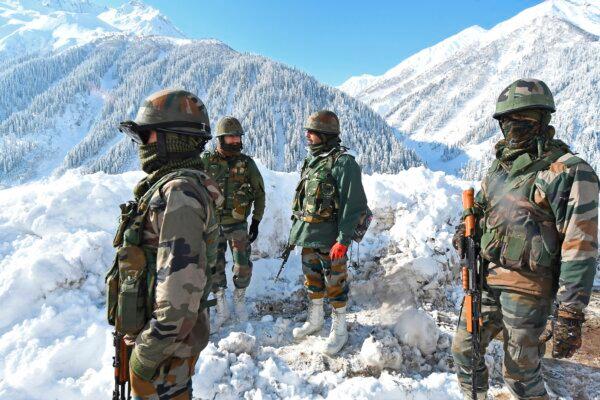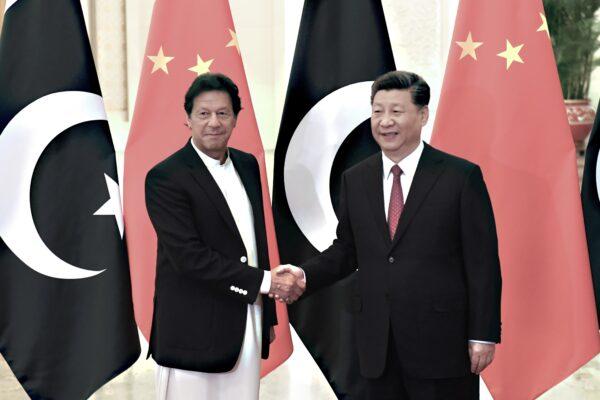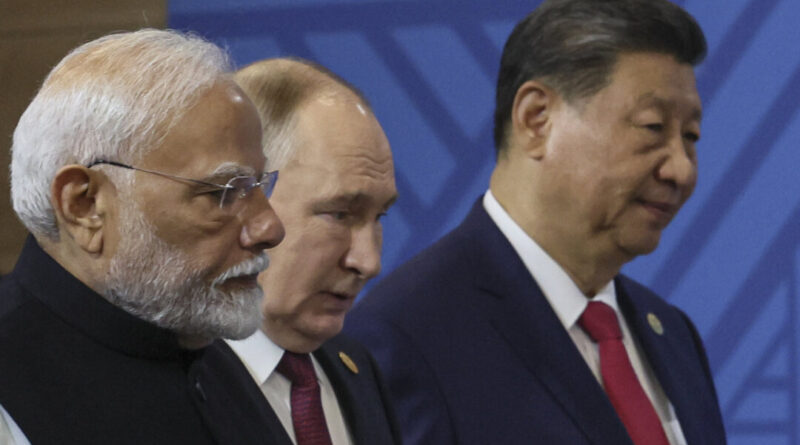Unveiling the Reasons for the India–China Border Disengagement Agreement
Experts suggest that the recent agreement between India and China to fully disengage militarily along their disputed border in eastern Ladakh may not establish a permanent border solution, as mutual concerns still exist.
News Analysis
NEW DELHI— A recent pact between India and China to completely disengage militarily along their contested border in eastern Ladakh has been influenced by intricate diplomacy between the two countries, as well as the timing of the U.S. elections and broader geopolitical shifts in the Indo-Pacific, according to experts.
This diplomatic process was not only evident in the military channels established to reduce tensions but was also apparent at various recent multilateral forums.
The agreement, announced on Oct. 21, followed the Shanghai Cooperation Organisation (SCO) Summit in Pakistan and preceded the BRICS Summit in Russia. Both India and China are key members of these intergovernmental organizations. The developments at the border also came ahead of the upcoming harsh winter season in the high-altitude region.
Satoru Nagao, a non-resident fellow at the Washington-based think tank Hudson Institute, told The Epoch Times that the India-China border pact is a significant geopolitical milestone in the Indo-Pacific region, linked to China’s evolving priorities in the area. China’s focus is currently not on India, as it aims to concentrate on Taiwan, the U.S. election, and the new administration in the White House.
“While India’s border claim remains unchanged, China has accepted it this time due to its preparations for a possible Trump victory in the U.S. and its readiness for a situation involving Taiwan,” Nagao mentioned before former U.S. President Donald Trump was declared the winner of the November election. “China desires a ceasefire on the India-China border to prioritize its activities in the Pacific region.”
Two days after the disengagement announcement, Indian Prime Minister Narendra Modi and Chinese leader Xi Jinping met formally for the first time since the deadly 2020 Galwan clash, during the 16th annual BRICS summit in Kazan on Oct. 23.
No Strategic Shift
Experts emphasized that the troop disengagement implies a mutual agreement on joint patrolling areas and a withdrawal of confrontational standpoints, rather than signaling a final resolution of the border dispute between the two nations.
“While Xi and Modi appear eager to mend ties and broaden mutually beneficial economic interactions— given that China is India’s top trading partner—the border pact does not necessarily indicate a fundamental strategic shift by Beijing and New Delhi,” Scobell remarked. “The border dispute is unlikely to be resolved anytime soon, as the two countries maintain divergent perspectives on their respective territorial claims and are unwilling to compromise.”
Indian External Affairs Minister S. Jaishankar described the agreement as the outcome of “patient and persevering diplomacy” during a New Delhi Television forum prior to his departure for BRICS.
“There were certain areas that were blocked by both sides after 2020. We have now reached an understanding that allows for patrolling similar to before 2020,” he noted at the forum.
Jaishankar had faced criticism from Chinese state media in an op-ed titled “India’s diplomacy has a ‘S. Jaishankar problem’” published on Sept. 9. The foreign minister had voiced concerns about China’s adversarial relationship with India on multiple occasions, insisting that bilateral ties should be conditional on maintaining peace and stability at the border.

Indian army soldiers stand on a snow-covered road near Zojila mountain pass that connects Srinagar to the union territory of Ladakh, bordering China on Feb. 28, 2021. Tauseef Mustafa/AFP via Getty Images
Moreover, the formal and informal meetings between the leaders of both nations, alongside the verbal exchanges between their respective representatives and various media outlets, were not isolated incidents, experts claim. These events align with their evolving diplomatic strategies, and the disengagement accord at the border is one part of this ongoing narrative—it is not the final resolution.
Diplomacy at SCO Summit
During the 2024 SCO Summit in Islamabad, Jaishankar indirectly criticized China and Pakistan on Oct. 16, with Chinese and Pakistani leaders Li Qiang and Shehbaz Sharif present. India shares disputed borders with both countries and opposes the China-Pakistan Economic Corridor (CPEC) project that traverses territory claimed by India but controlled by Pakistan.
“Where trust is lacking or cooperation is inadequate, where friendships fall short and neighborly relations are absent, there is certainly a need for introspection and redressal,” Jaishankar remarked. “The aim is to strengthen mutual trust, friendships, and good neighborliness, enhance multidimensional cooperation, especially regionally, and be a positive force promoting balanced growth, integration, and conflict prevention.”
He also emphasized the importance of mutual respect and criticized unilateral agendas, directing his comments once again at China.
“Cooperation must be based on mutual respect and sovereign equality, acknowledging territorial integrity and sovereignty. It should be grounded on authentic partnerships, not one-sided interests. Progress can’t be made if we cherry-pick global norms, especially in trade and transportation,” he stated.

Chinese leader Xi Jinping shakes hands with Pakistani Prime Minister Imran Khan before a meeting at the Great Hall of the People in Beijing, China, on April 28, 2019. Madoka Ikegami/Getty Images
Madhav Nalapat, a geopolitical analyst, informed The Epoch Times in an email that India does not support China’s Belt and Road Initiative projects, which have resulted in significant debts for host countries.
“India does not endorse projects that ultimately harm a country,” Nalapat stated.
He added that he doesn’t anticipate China and Pakistan to address India’s concerns immediately after Jaishankar’s speech, but believes that the SCO provides an international platform for India to assert its position.
Michael Kugelman, director of the South Asia Institute at the Wilson Center in Washington, told The Epoch Times not to overemphasize the impact of Jaishankar’s remarks at the SCO on India-China relations or the broader geopolitical dynamics in the region.
“Ultimately, the meeting did not yield any significant tangible outcomes because this is a forum where some countries, like India, China, and Pakistan, don’t see eye to eye,” Kugelman commented.
He added that issues like poverty alleviation, climate change mitigation, connectivity promotion, and counterterrorism efforts received a great deal of emphasis due to the varying viewpoints within the group.
“All these proposals sound positive and garner rhetorical support. When Jaishankar mentions that terrorist activities need to be addressed, everyone understands he is referring to Pakistan. But, as of now, India and Pakistan remain at odds over terrorist activities, among other issues,” he explained.
Security Concerns in Pakistan
Burzine Waghmar from the School of Oriental and African Studies (SOAS) at the University of London mentioned in an email to The Epoch Times that two Chinese engineers working on a power project were killed in a suicide attack in Pakistan two weeks before the SCO summit began, and Li Qiang brought up this incident with Pakistan. Despite such setbacks, China has not lost confidence in Pakistan.
“Xi had specifically urged PM Shehbaz Sharif at the SCO Samarkand summit in September 2022 to ensure the safety of Chinese companies and workers operating in Pakistan under frequent attack since the inception of the CPEC,” Waghmar explained.
Thousands of Chinese engineers are working on economic corridor projects in Pakistan, and Waghmar stated that China trusts the Pakistan army to handle the recurring attacks.
Shortly after the suicide bombing incident, Li and Sharif attended the inauguration of an airport in southwest Pakistan funded by Beijing. Earlier, Pakistan established a special security division of the military to protect the CPEC, comprising an “approximately 13,000-strong contingent of battalions and paramilitary forces,” Waghmar mentioned.
He noted that the Pakistan army headquarters in Rawalpindi has not disclosed the number of personnel or the cost of the military unit tasked with safeguarding Chinese expatriates.
In addition to Pakistan’s security division for the CPEC’s protection, Nagao indicated that China has taken its own measures to ensure the safety of the route linking Xinjiang with Pakistan’s entire length.
“This is why Chinese military and Chinese private military companies are now deployed in Pakistan. Naturally, this plan poses a threat to India. First, the China-Pakistan alliance in itself poses a threat. Secondly, the growing number of Chinese military forces in South Asia and the Indian Ocean poses a threat to India. Thirdly, Gligit-Baltistan is an area India claims as part of Kashmir. Consequently, China’s CPEC project poses a threat to India.”
Diplomacy at BRICS
Nagao highlighted that BRICS is a crucial international forum for India-China diplomacy and their developments concerning the border issue.
He delineated that China faces three types of threats from India currently: security, economic, and diplomatic hazards.
“China’s security threat relates to the land border and issues in the Indian Ocean. The economic threat comes from China’s dominance in critical technologies, markets, and supply chains, i.e., economic security. The diplomatic threat arises from the Global South’s influence,” Nagao elaborated.
He expressed that if China continues expanding its sphere of influence in the Global South, its aspiration
Source link





